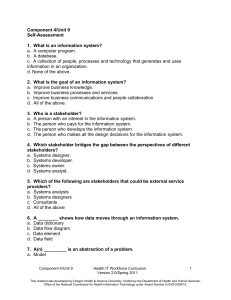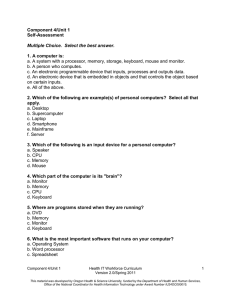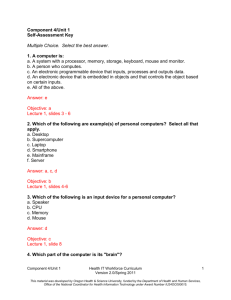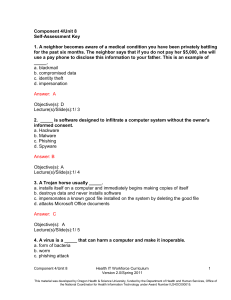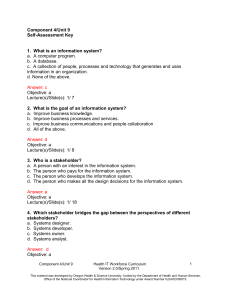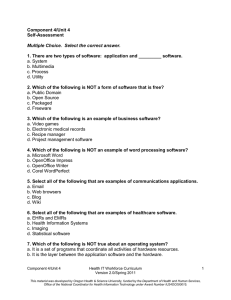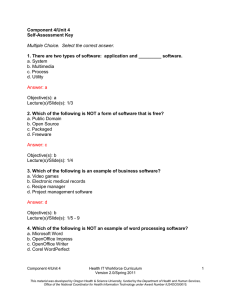Component 4/Unit 8 Self-Assessment
advertisement
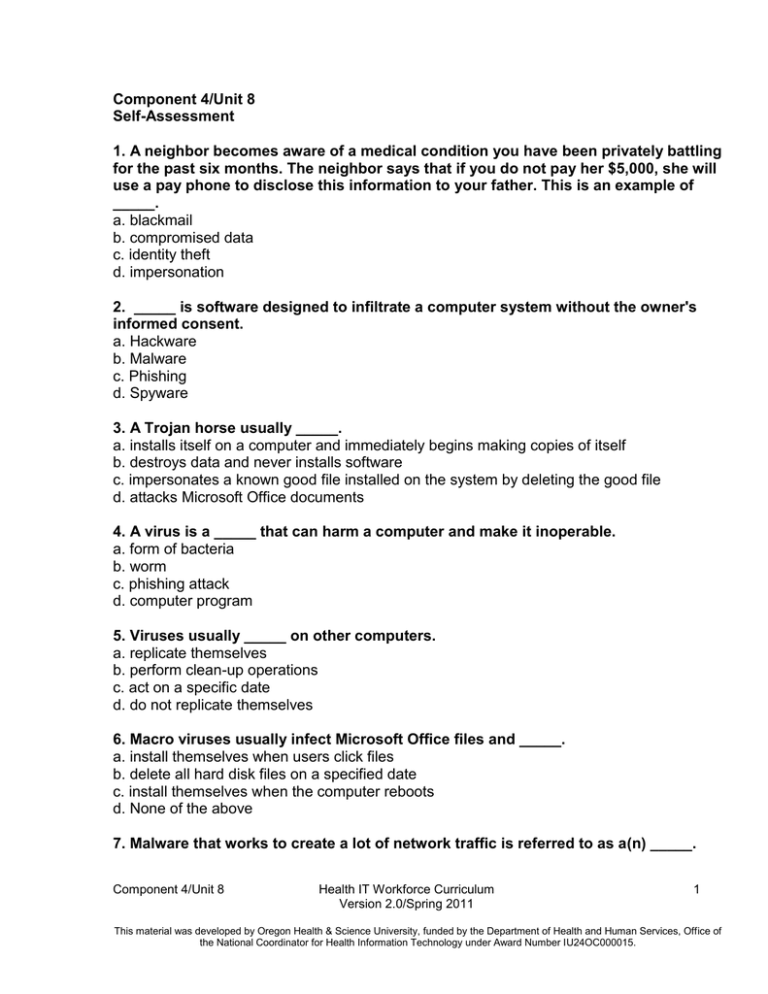
Component 4/Unit 8 Self-Assessment 1. A neighbor becomes aware of a medical condition you have been privately battling for the past six months. The neighbor says that if you do not pay her $5,000, she will use a pay phone to disclose this information to your father. This is an example of _____. a. blackmail b. compromised data c. identity theft d. impersonation 2. _____ is software designed to infiltrate a computer system without the owner's informed consent. a. Hackware b. Malware c. Phishing d. Spyware 3. A Trojan horse usually _____. a. installs itself on a computer and immediately begins making copies of itself b. destroys data and never installs software c. impersonates a known good file installed on the system by deleting the good file d. attacks Microsoft Office documents 4. A virus is a _____ that can harm a computer and make it inoperable. a. form of bacteria b. worm c. phishing attack d. computer program 5. Viruses usually _____ on other computers. a. replicate themselves b. perform clean-up operations c. act on a specific date d. do not replicate themselves 6. Macro viruses usually infect Microsoft Office files and _____. a. install themselves when users click files b. delete all hard disk files on a specified date c. install themselves when the computer reboots d. None of the above 7. Malware that works to create a lot of network traffic is referred to as a(n) _____. Component 4/Unit 8 Health IT Workforce Curriculum Version 2.0/Spring 2011 1 This material was developed by Oregon Health & Science University, funded by the Department of Health and Human Services, Office of the National Coordinator for Health Information Technology under Award Number IU24OC000015. a. Macro virus b. worm c. adware d. phishing 8. You receive an email that appears to be from eBay asking you to login to verify a transaction. This is an example of (a) ________ attack. a. worm b. virus c. phishing d. buyware 9. A _____ is a free protocol analyzer software tool that can display unencrypted network traffic on a monitor screen. a. packet sniffer b malware-analyzer c. spyware tracer d. server 10. Network security revolves around the setup and use of _____ to control who and how objects are utilized. a. identification b. authentication, authorization, and permissions c. authentication and permissions d. packet sniffers 11. An authenticated object is an object that _____. a. is able to print a document b. in a directory c. proved its identity d. can delete a file in a folder 12. An example of authentication is when a user _____. a. is able to delete a file b. can print a document c. shuts down a computer d. logs into a computer 13. An example of authorization is when a user _____. a. logs into a computer b. can print a document c. Both A and B d. None of the above Component 4/Unit 8 Health IT Workforce Curriculum Version 2.0/Spring 2011 1 This material was developed by Oregon Health & Science University, funded by the Department of Health and Human Services, Office of the National Coordinator for Health Information Technology under Award Number IU24OC000015. 14. _____ permissions are set so that users have the ability to access files and folders over a network. a. NTFS b. Network c. LAN d. Sharing 15. _____ permissions are set so that users have the ability to view, make changes to, or delete files in a folder. a. NTFS b. Network c. LAN d. Sharing 16. Your company decides that it should back up computer files every four hours during the week and at the end of the day on weekends. This process needs to be recorded in the company’s _____. a. permissions b. security policy c. WAN documentation d. email 17. In three factor authentication, an object must present _____ to be authenticated. a. something it knows and at least one other authentication factor item b. a username and password c. something it knows, something it has, and something it is d. Either A or B 18. Software and/or hardware that blocks unauthorized communications on a computer is referred to as a(n) _____. a. packet sniffer b. switch c. hub d. firewall 19. _____ protect(s) a computer by locating and stopping programs attempting to harm computer operation. a. Antivirus software b. Firewalls c. Routers d. Spyware 20. _____ are hardware and/or software that monitor network traffic for malicious activity. Component 4/Unit 8 Health IT Workforce Curriculum Version 2.0/Spring 2011 1 This material was developed by Oregon Health & Science University, funded by the Department of Health and Human Services, Office of the National Coordinator for Health Information Technology under Award Number IU24OC000015. a. Routers b. Intrusion Protection Systems c. Packet sniffers d. Antivirus installations 21. Encryption is a process whereby communication is made unreadable to _____. a. everyone b. authorized viewers c. unauthorized viewers d. None of the above 22. A simple step to secure data from those who do not have permission view it is to _____. a. store the data on a flash drive b. move the data on a corporate Web server c. perform a background check on all employees d. require employees to lock their computers when they leave their desk 23. A complex password contains at least 6 characters, made up of at least: 1-upper case, 1-lower case, 1-number, and 1- _____ character. a. special b. numeric c. typed d. authorized 24. Physical security of assets means that objects cannot access data without _____. a. use of a badge b. authentication c. written permission d. the proper security clearance 25. In wireless networking, a WAP’s SSID represents _____. a. the router’s name b. the WPA preshared key c. the name of the wireless network d. None of the above 26. You were asked to configure wireless authentication. Which protocol should you select? a. WEP b. NTFS c. WLAN d. WPA2 Component 4/Unit 8 Health IT Workforce Curriculum Version 2.0/Spring 2011 1 This material was developed by Oregon Health & Science University, funded by the Department of Health and Human Services, Office of the National Coordinator for Health Information Technology under Award Number IU24OC000015. 27. The U. S. Government would like to implement electronic health records for most Americans by the year _____. a. 2030 b. 2016 c. 2020 d. 2014 28. Health information is stored as a(n) _____ in an EHR. a. folder b. table c. record d. entity 29. HIPAA requires that health care providers, insurance companies, and employers abide by _____ standards. a. accountability b. privacy and security c. state d. international 30. Privacy is to _____ as confidentiality is to _____. a. people; data b. security; blackmail c. blackmail; security d. data; people 31. The law of _____ regulates the type of information which may be collected and how this information may be used and stored. a. security b. privacy c. confidentiality d. torts 32. _____ is commonly applied to conversations between doctors and patients. a. Security b. Privacy c. Confidentiality d. Tort law 33. When users enter data on Web forms, the data should be _____ before it is saved to the database. a. scrubbed b. committed c. balanced Component 4/Unit 8 Health IT Workforce Curriculum Version 2.0/Spring 2011 1 This material was developed by Oregon Health & Science University, funded by the Department of Health and Human Services, Office of the National Coordinator for Health Information Technology under Award Number IU24OC000015. d. validated 34. One way to improve data security is to require that all Web access of health records be done via _____. a. HTTP b. XML c. HTTPS d. FTP Component 4/Unit 8 Health IT Workforce Curriculum Version 2.0/Spring 2011 1 This material was developed by Oregon Health & Science University, funded by the Department of Health and Human Services, Office of the National Coordinator for Health Information Technology under Award Number IU24OC000015.
